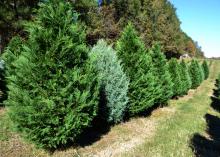Information Possibly Outdated
The information presented on this page was originally released on November 10, 2017. It may not be outdated, but please search our site for more current information. If you plan to quote or reference this information in a publication, please check with the Extension specialist or author before proceeding.
Christmas tree demand high, extra rains help growers
RAYMOND, Miss. -- After two years of drought, Mississippi Christmas tree growers welcomed the extra rain in 2017.
“In a few low-lying areas, excessive rain in May and June waterlogged the soil and killed some trees, but this was not widespread,” said Stephen Dicke, a forestry specialist with the Mississippi State University Extension Service. “We will always take more rain over less rain.”
These few tree losses will not impact 2017 production, which Dicke expects to be similar to last year’s. Growers likely will sell more than 30,000 trees, but they still will not meet existing consumer demand.
“Our growers can’t grow enough trees,” Dicke said. “Our larger growers are supplementing their supply with Frasier firs from North Carolina. Some of them are getting as much as 40 percent of their inventory like this. They’d like to produce all of the trees they need, but they just can’t because of space and the growing cycle.”
Mississippians who want a live tree should get to the tree farm early. The peak sales day for Christmas tree growers is the Saturday after Thanksgiving. By the second week of December, most tree producers are sold out. Tree prices depend on the market and tree quality each year. Most growers sell their trees for between $8 and $10 per foot, Dicke said.
Michael May, owner of Lazy Acres Farm in Newton County near Chunky, said he expects his trees to go quickly. Although he lost about 100 future trees to the heavy rainfall, his inventory will be close to what it was last year.
“Our available trees this year will be a little bit down, but not because of the rain,” May said. “In the last four to five years, we’ve moved some fields around, which caused our numbers to be down a little this year. But we are bringing in a nice number of precut trees for more inventory.”
May’s parents established the Christmas tree farm in the 1980s to generate supplemental income. May and his wife, Cathy, bought the farm in 2001 and developed a year-round agritourism business that offers event venues and seasonal attractions, including a pumpkin patch, a Christmas light show and an Easter event.
Like the May’s farm, many Christmas tree farms in the state are family owned and operated.
“Most Christmas tree growers produce trees as a supplement to other income,” Dicke said. “Most growers aren’t looking to expand. They are happy with the workload they have and the volumes and qualities currently in production. So, the opportunity is there for new growers to serve customers looking for locally grown trees. In fact, we do have a few new growers selling trees for the first time this year.”
A fresh, live tree is the safest tree to enjoy if it is properly cared for, Dicke said.
“That means lots of water,” he said. “Locally grown trees will need much more water than lot-purchased Christmas trees from up north. People should use a tree stand that holds at least 1 gallon of water. A stand that holds 2 gallons is better. Stands should be filled daily. The trees will use up to 2 gallons of water a day, especially the first few days.”
For a list of Christmas tree farms in Mississippi, visit the Southern Christmas Tree Association website (http://www.southernchristmastrees.org/MS-Farms.html) or contact the Extension office.


